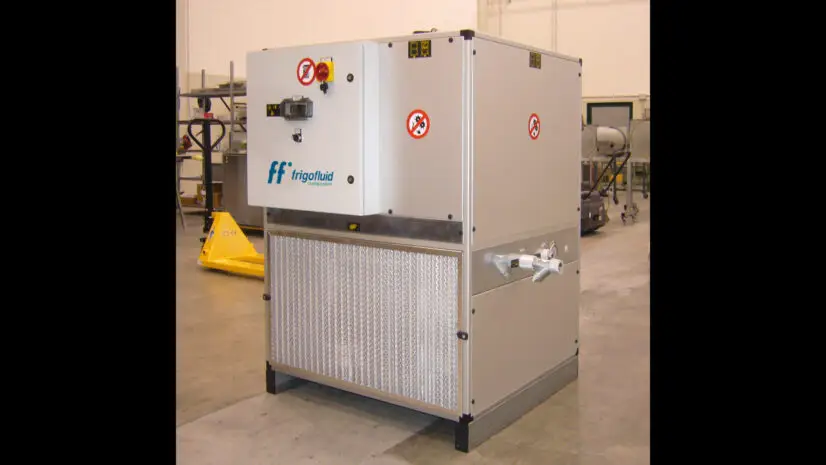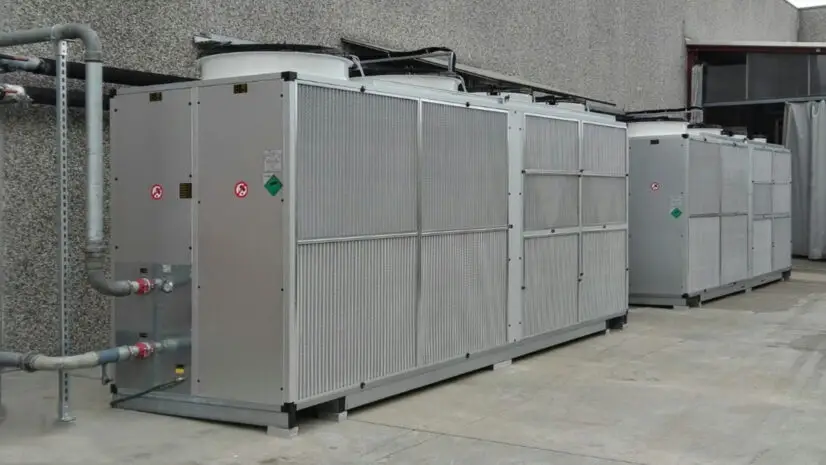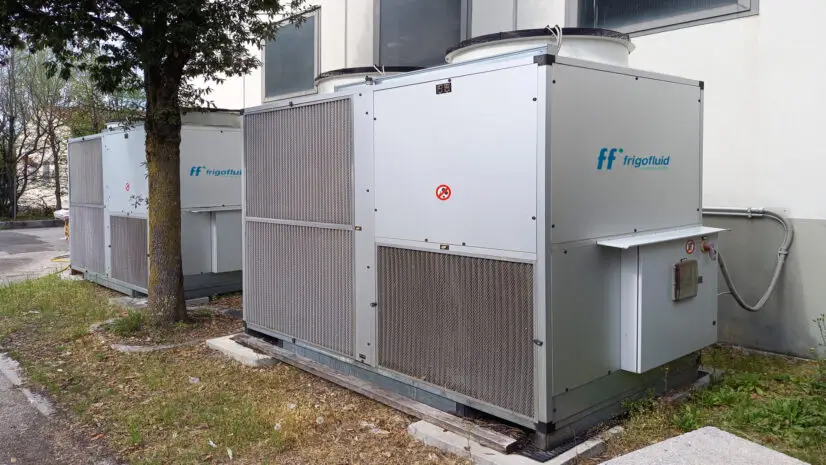Free-Cooling Chiller: what it is and how it works

Performance, performance and more performance. Or is it? In many cases, the demand of mechanical companies and their operations managers is, certainly, to efficiently dispose of heat from process fluids, even reaching room temperature at certain times. But it is also essential not to overdo it with energy use if, at certain times of the day or year (and for process reasons), this is not necessary. Chillers with free cooling technology meet exactly this demand of theirs.
We are talking about “smart” industrial refrigeration, capable of using exactly the resources needed at a given time: what makes it possible to contribute to a company’s sustainability, both in economic and environmental terms.
But first, what does it mean and what is the definition of “free cooling”? And how does a cooling chiller equipped with free cooling technology work? Let’s look at it together.
1. Intro: free cooling
What is meant by free cooling? And what does the term mean?
Free cooling, which literary means “cooling which is free-of-charge”, takes advantage of cold outside air to cool process fluids within an industrial plant or civil buildings (HVAC sector). In other words, free cooling mode makes use of a natural and free source of cooling such as ambient air, lowering the overall system consumption and, consequently, the costs in the bill: water is in fact not provided as a cooling resource. And in fact, the first and most obvious advantage of free cooling is not having to use that resource-a no small factor, for example, in highly arid locations and climates.
So where can free cooling be used?
To answer this question, we need to pay attention to a terminological aspect. In fact, “free cooling,” or it would be better to say “low-cost cooling” (since we have to consider the contribution of the energy resource for the operation of the machine), can be applied in two somewhat heterogeneous areas: namely, in the air conditioning of rooms and in the cooling of process fluids.
Of course, we are now interested in the latter. In this sphere, “free cooler” can be used as a synonym for “dry cooler” or “air cooler” (or again, “system with dry cooler”): this is, in fact, the system that uses only air as a means of fluid cooling. What allows us to emphasize an additional advantage of free cooling systems: structural simplicity. This translates into minimal wear and tear on internal components and a reduction in the amount of routine maintenance required. Hence greater reliability and, in many cases, longer service life.
Returning to the question about the use of free cooling (in fluid cooling), if the industrial or civil plant to be cooled faces significant water shortages, then free cooling might be the right answer.
All this, other factors being equal: of course, as with any industrial cooling and refrigeration system, the advantages are relative to the specific project requirements. In fact, in some contexts it may be useful to leverage (moderate) amounts of water to increase performance while still using additional energy. In other cases, the required performance makes it necessary to use industrial chillers-perhaps alternating with a free cooling mode.
But let’s go in order.
Find Frigofluid Free-Cooling Chillers2. Free-cooling chiller: mode of operation and advantages
Not just dry coolers: free cooling can be not only a “stand-alone” solution, so to speak, but also one of the modes of operation of industrial chillers. So what is the purpose of a chiller with free cooling technology and how does it work?
We have seen how an industrial compression chiller is a complex machine, equipped with numerous components: both related to the cooling circuit and as auxiliary constituent parts. Here it will suffice to say that this “structural complexity” is intended to bring process fluids to temperatures even below the wet bulb temperature of the surrounding air (a task impossible to other machines): high performance, but with considerable energy use.
Now, it is not always (during the day or throughout the year) necessary to leverage this performance and energy use.
This is where free-cooling chillers come in: thanks to their “on-board computer,” properly parameterized, these systems take an intelligent approach, automatically adapting to outdoor weather conditions. Indeed, chillers of this type integrate the different operating modes typical of their respective “standard” solutions, ensuring optimal operation in every season.

Concretely, how does this take place? To make this clear, let’s look at the three modes in which chillers with free cooling technology operate.
- “Summer” mode: when outdoor temperatures exceed a certain threshold (for example, about 23°C), the chiller operates in the traditional way, using the compressors to reach the desired flow temperature. At this stage, the possible energy savings, which modern industrial chillers are certainly capable of ensuring, lie in the quality of its standard components and the manufacturer’s construction expertise.
- “Winter” mode: in the cold months, for example, with outside temperatures below about 5°C, the chiller can operate exclusively in free cooling mode, making maximum use of cold outside air. The compressors remain completely off, resulting in even more significant energy savings.
- “Intermediate” season: during periods with moderate outdoor temperatures, the system combines both modes. During night and morning hours, when temperatures are lower, the chiller uses free cooling. In contrast, during the day, as outdoor temperatures rise, the system switches to conventional mode.
So it is clear how the operating principle can be summarized in these points.
- Priority to free cooling: the system gives priority to free cooling when outdoor conditions are favorable (sufficiently low air temperature). Outside air is fed directly into the heat exchanger to cool the process fluid.
- Activation of alternative systems: if the outdoor temperature is not cold enough for effective free cooling, the system automatically activates the refrigeration compressors to provide the required cooling.
- Smart integration: the system manages the transition between free cooling and alternative systems intelligently, optimizing energy consumption and minimizing compressor utilization, through the on-board computer (appropriately parameterized).
To optimize the operation of the free cooling system, it is important to install the chiller in a well-ventilated area protected from the weather. In addition, it is essential to constantly monitor outdoor weather conditions and adjust chiller settings accordingly.
Adopting chillers with free cooling technology offers a number of tangible benefits.
- Significant energy savings: Free cooling enables significant reductions in energy use, with savings of up to 90 percent. This means cutting utility bills by a large margin-a no small advantage with small and large companies often in “spending review.”
- Reduced environmental impact: lower energy consumption means lower CO2 and greenhouse gas emissions. Chillers with free cooling thus contribute to the fight to promote more sustainable production.
- Increased reliability and durability: less use of compressors reduces wear and tear on the chiller’s mechanical components. This increases its reliability over time, extends service life and reduces maintenance costs.
3. When a chiller with free cooling is needed and its applications
We conclude with applications of chillers with free cooling technology. Whether an industrial chiller of this type is chosen depends on several factors. Here are some of them.
- Required cooling capacity: the cooling capacity of the chiller must be adequate for the specific needs of the industrial process.
- Desired output temperatures: this is another key parameter for sizing the system, also considering the maximum and minimum times during the year.
- Space availability: a parameter that is not irrelevant in companies with not much space available.
- Climatic conditions: the choice of chiller must take into account the installation air. In fact, there are special technical specifications for more or less arid environments (and for use of air only or even water for mechanical cooling). In any case, chillers with free cooling are a valuable ally.

It tends to be every engineering industry with a need for heat dissipation in process fluids. This is all the more true for chillers with free cooling, for monitorable energy savings. Clearly, the use of these two combined modes is especially advisable in very energy-intensive industries and processes.
Here are some examples.
- Data centers: it is now clear to everyone how critical thermal management is in these environments. Indeed, the need for heat disposal is significant and constant over time. Chillers with free cooling make it possible, under certain conditions, to reduce the high energy use.
- Power generation: in power generation facilities, such as power plants and cogeneration plants, “air-only cooling” can be used to dissipate heat from individual components and fluids.
- Food industries: these often require precise process temperatures at certain stages of the process or year to preserve product quality. This precision is an added benefit of chillers with free cooling tenology, systems that are versatile as well as sustainable.
- Other industrial processes: in various industries, such as paper production, metal processing, and chemical production, free cooling applied to a classic industrial chiller can be used to cool machinery and fluids, optimizing energy consumption and sustainability.
Resources
Plants and components
Find out all Frigofluid's productsComparing Different Technologies
Find out all the different technologiesFind out more
All technical articlesOur Newsletter
Subscribe to the Frigofluid newsletter: stay up-to-date on technical solutions for industrial refrigeration and cooling and get to know our offer.